Contents
- The climate of Sedona
- The best time to visit Sedona
- The worst time to visit Sedona
- Spring weather in Sedona
- Summer weather in Sedona
- Autumn weather in Sedona
- Winter weather in Sedona
- Weather in January
- Weather in February
- Weather in March
- Weather in April
- Weather in May
- Weather in June
- Weather in July
- Weather in August
- Weather in September
- Weather in October
- Weather in November
- Weather in December
- Frequently asked questions
- Average temperature
- Average pressure
- Average wind speed
- Average humidity
- Average rainfall
- Average rainfall days
- Average snowfall
- Average snowfall days
- Average daylight
- Average sunshine
- Average sunshine days
- Average UV index
- Average cloud cover
- Average visibility

Climate and monthly weather forecast
The climate of Sedona
Sedona, located in Arizona, USA, observes a significant variation in temperatures, rainfall, humidity levels and other weather conditions throughout the year. This variation results in the unique climate for which the city is renowned.
Based on data, the city experiences its high temperatures from 46°F (7.8°C) in January to a sizzling 84.7°F (29.3°C) in July. Similarly, the winter season sees the lowest temperatures drop from 28.8°F (-1.8°C) in January down to 27.9°F (-2.3°C) in December. It is this wide temperature range that sets Sedona apart, creating a climate where each season is distinctly different and easily recognizable.
Rainfall is another defining characteristic of Sedona’s climate. The data indicates that July witnesses the highest precipitation, recording an average of 2.28" (58mm) of rain, while June is the driest month, with just 0.16" (4mm) of rain on average.
Unique weather patterns in Sedona include a notable absence of snow from May to November, with December seeing the most snowfall at 2.68" (68mm). The city also observes its maximum daylight hours in June, 14.5 hours on average, and the highest UV index from June through August - a factor to be reckoned with for tourists planning a visit during these months.
The best time to visit Sedona
The worst time to visit Sedona
Spring weather in Sedona
Summer weather in Sedona
Autumn weather in Sedona
Winter weather in Sedona
Weather in January
Weather in February
Weather in March
Weather in April
Weather in May
Weather in June
Weather in July
Weather in August
Weather in September
Weather in October
Weather in November
Weather in December
Published by: Weather U.S. | About Us
Data Sources | Weather Forecasting & Climate
Frequently asked questions
What is the most humid month?
How many days does it rain?
When does it snow?
How much does it snow?
When is the lowest UV index?
When it does not snow?
What is the least humid month?
What is the driest month?
When are the longest days?
When is the highest UV index?
What part of the year is the hottest?
What is the wettest month?
What month has the most sunshine?
What is the coldest month in Sedona?
What is the snowiest month?
What is the month with the shortest days?
Is there Daylight Saving Time (DST)?
What is the month with the least sunshine in Sedona?
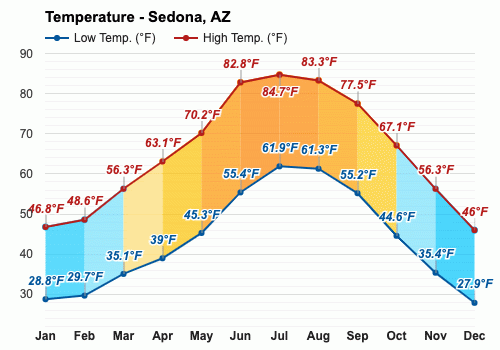
Average temperature
Sedona, AZ
The warmest month (with the highest average high temperature) is July (84.7°F).
The month with the lowest average high temperature is December (46°F).
The month with the highest average low temperature is July (61.9°F).
The coldest month (with the lowest average low temperature) is December (27.9°F).

Average pressure
Sedona, AZ
- Average pressure in January:
30.13"Hg - Average pressure in February:
30.05"Hg - Average pressure in March:
29.99"Hg - Average pressure in April:
29.91"Hg - Average pressure in May:
29.87"Hg - Average pressure in June:
29.86"Hg
- Average pressure in July:
29.93"Hg - Average pressure in August:
29.93"Hg - Average pressure in September:
29.93"Hg - Average pressure in October:
29.97"Hg - Average pressure in November:
30.05"Hg - Average pressure in December:
30.09"Hg
The month with the highest atmospheric pressure is January (30.13"Hg).
The month with the lowest atmospheric pressure is June (29.86"Hg).
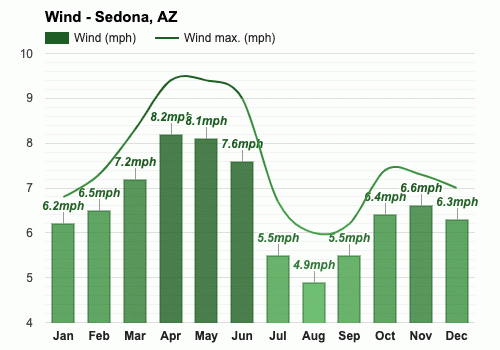
Average wind speed
Sedona, AZ
- Average wind speed in January:
6.2mph - Average wind speed in February:
6.5mph - Average wind speed in March:
7.2mph - Average wind speed in April:
8.2mph - Average wind speed in May:
8.1mph - Average wind speed in June:
7.6mph
- Average wind speed in July:
5.5mph - Average wind speed in August:
4.9mph - Average wind speed in September:
5.5mph - Average wind speed in October:
6.4mph - Average wind speed in November:
6.6mph - Average wind speed in December:
6.3mph
The windiest month (with the highest average wind speed) is April (8.2mph).
The calmest month (with the lowest average wind speed) is August (4.9mph).

Average humidity
Sedona, AZ
The month with the highest relative humidity is January (62%).
The month with the lowest relative humidity is June (24%).
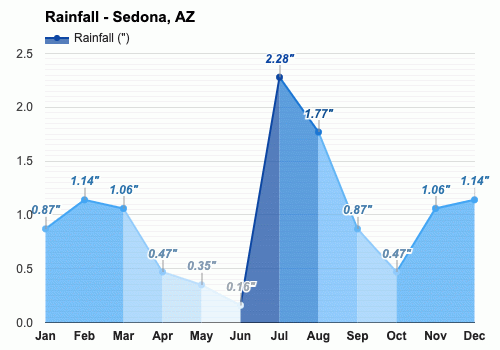
Average rainfall
Sedona, AZ
- Average rainfall in January:
0.87" - Average rainfall in February:
1.14" - Average rainfall in March:
1.06" - Average rainfall in April:
0.47" - Average rainfall in May:
0.35" - Average rainfall in June:
0.16"
- Average rainfall in July:
2.28" - Average rainfall in August:
1.77" - Average rainfall in September:
0.87" - Average rainfall in October:
0.47" - Average rainfall in November:
1.06" - Average rainfall in December:
1.14"
The wettest month (with the highest rainfall) is July (2.28").
The driest month (with the least rainfall) is June (0.16").

Average rainfall days
Sedona, AZ
- Average rainfall days in January:
6.3 days - Average rainfall days in February:
4.9 days - Average rainfall days in March:
6.8 days - Average rainfall days in April:
5.5 days - Average rainfall days in May:
4.6 days - Average rainfall days in June:
2.8 days
- Average rainfall days in July:
16.2 days - Average rainfall days in August:
13.8 days - Average rainfall days in September:
8.9 days - Average rainfall days in October:
5.2 days - Average rainfall days in November:
4.5 days - Average rainfall days in December:
6.5 days
The month with the highest number of rainy days is July (16.2 days).
The month with the least rainy days is June (2.8 days).

Average snowfall
Sedona, AZ
The month with the highest snowfall is December (2.68").
The months with the least snowfall are May, June, July, August, September and October (0").

Average snowfall days
Sedona, AZ
- Average snowfall days in January:
2 days - Average snowfall days in February:
2.9 days - Average snowfall days in March:
1 days - Average snowfall days in April:
0.3 days - Average snowfall days in May:
0 days - Average snowfall days in June:
0 days
- Average snowfall days in July:
0 days - Average snowfall days in August:
0 days - Average snowfall days in September:
0.1 days - Average snowfall days in October:
0 days - Average snowfall days in November:
0.8 days - Average snowfall days in December:
3.5 days
The month with the highest number of snowfall days is December (3.5 days).
The months with the least snowfall days are May, June, July, August and October (0 days).
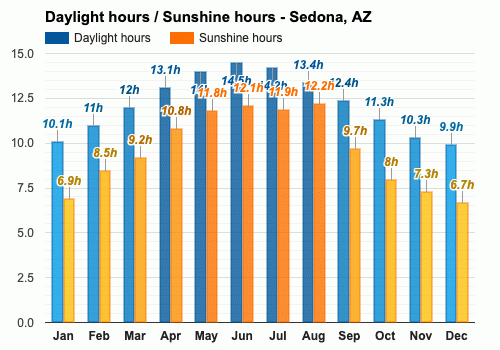
Average daylight / Average sunshine
Sedona, AZ
- Average daylight in January:
10h and 1min - Average daylight in February:
11h and 0min - Average daylight in March:
12h and 0min - Average daylight in April:
13h and 1min - Average daylight in May:
14h and 0min - Average daylight in June:
14h and 3min
- Average daylight in July:
14h and 1min - Average daylight in August:
13h and 2min - Average daylight in September:
12h and 2min - Average daylight in October:
11h and 2min - Average daylight in November:
10h and 2min - Average daylight in December:
9h and 5min
The month with the longest days is June (Average daylight: 14h and 30min).
The month with the shortest days is December (Average daylight: 9h and 54min).
- Average sunshine in January:
6h and 5min - Average sunshine in February:
8h and 3min - Average sunshine in March:
9h and 1min - Average sunshine in April:
10h and 5min - Average sunshine in May:
11h and 5min - Average sunshine in June:
12h and 1min
- Average sunshine in July:
11h and 5min - Average sunshine in August:
12h and 1min - Average sunshine in September:
9h and 4min - Average sunshine in October:
8h and 0min - Average sunshine in November:
7h and 2min - Average sunshine in December:
6h and 4min
The month with the most sunshine is August (Average sunshine: 12h and 12min).
The month with the least sunshine is December (Average sunshine: 6h and 42min).

Average sunshine days
Sedona, AZ
- Average sunshine days in January:
23.7 days - Average sunshine days in February:
20.8 days - Average sunshine days in March:
23.5 days - Average sunshine days in April:
24.2 days - Average sunshine days in May:
24.7 days - Average sunshine days in June:
26 days
- Average sunshine days in July:
9.9 days - Average sunshine days in August:
11.1 days - Average sunshine days in September:
16.8 days - Average sunshine days in October:
24.8 days - Average sunshine days in November:
25 days - Average sunshine days in December:
22.7 days
The month with the most sunshine days is June (26 days).
The month with the least sunshine days is July (9.9 days).
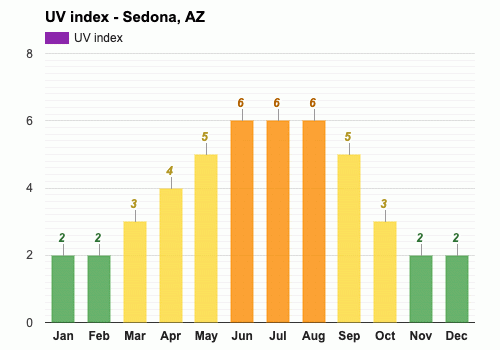
Average UV index
Sedona, AZ
The months with the highest UV index are June, July and August (UV index 6).
The months with the lowest UV index are January, February, November and December (UV index 2).

Average cloud cover
Sedona, AZ
The month with the most cloud cover is December (Cloud cover 24).
The month with the least cloud cover is June (Cloud cover 6).

Average visibility
Sedona, AZ
The months with the highest visibility are January, February, March, April, May, June, July, August, September, October, November and December (6mi).
The months with the lowest visibility are January, February, March, April, May, June, July, August, September, October, November and December (6mi).